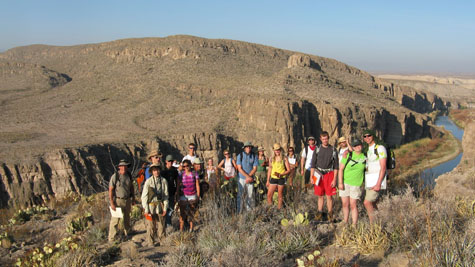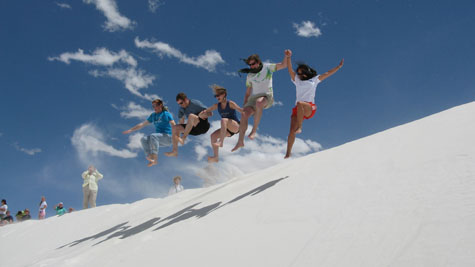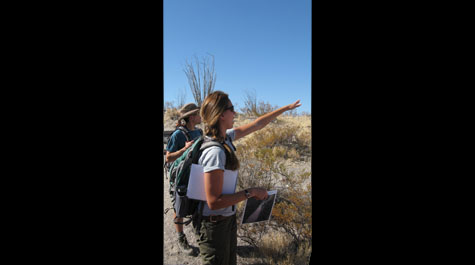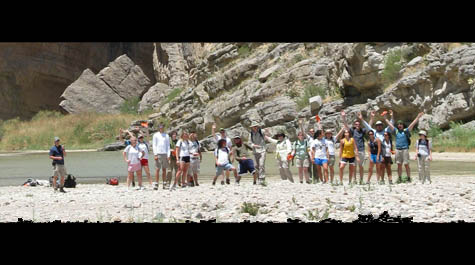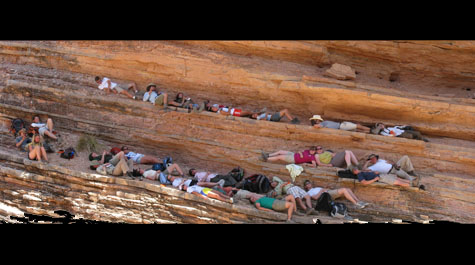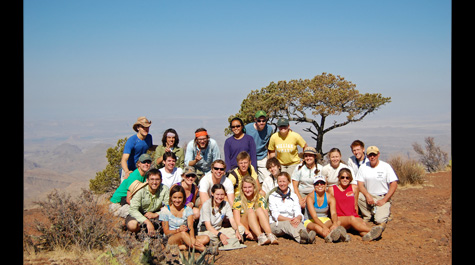Don't Feed the Bears: Adventures in and Around Big Bend National Park, Texas
Two days after graduation, a flock of 26 William and Mary geologists descended upon El Paso, Texas for our two week long Regional Field Geology course, focused this year primarily on the geology of Big Bend National Park and surrounding areas. We eventually rolled out into the desert in a veritable fleet of minivans headed by our fearless leaders (Professors Brent “Doc Otis” Owens and Linda “Mama” Morse) in our flagship, a Chevy Suburban.
We camped the first two nights in a wind tunnel known as the Franklin Mountains and spent the days venturing out to New Mexico for some spectacular geologic tourism. There, we visited White Sands National Monument (and missile testing range) home to towering dunes of white gypsum sands. Perhaps mistaking the pure white sand for snow, the class procured a sled and some wax and hit the slopes for an afternoon of desert merriment. We also visited Kilbourne Hole, which was off the beaten path to say the least. The hole is a massive crater left behind by explosive eruptions caused by magma hitting the water table. While the Hole itself was certainly striking, we were more interested in the treasures hidden inside preserved lava flows at the bottom of the Hole- mantle xenoliths (inclusions of peridotite from the mantle sometimes preserved in basalt from explosive eruptions).
Then it was time to make our way to Big Bend National Park. We stopped at a fair number of road cuts along the way, but none could match the spectacular scenery awaiting us in the park. We camped in the Chisos Basin, which boasts a lovely view through 'the Window', and a gang of (very) friendly neighborhood skunks. Though we had been discussing and researching the park’s geology all semester, we thought it would be beneficial to attend a talk by Big Bend’s own “Ranger Rock” (a rock with a hat, and his human ranger friend) to further cozy up with pertinent concepts. It was a lively presentation and a nice introduction to the basics of Texas’ geology.
Ranger Rock was not the only expert we visited on our trip- we ran into an esteemed W&M geo alum working in the Park, Sarah King ‘09, who took us on an educational hike through Tuff Canyon (actually made of pumice lapilli). Additionally, we met the park geologist, Don Corrick, who updated us on the most recent developments in the Park’s complex geological story. Steve Wick, owner of Ten Bits Ranch located just outside the Park, took us on a guided paleontological tour of fossil sites chock full of dinosaur and other reptilian remains (most notable was the site of the discovery of the previously unknown turtle species, Chupacabrachelys complexus). Then we hunted for our very own ~70 million year old shark teeth! (Yes, West Texas once had sharks… and water.)
Back in the Park, we went on several short hikes (and one rather long one) to spectacular geologic features and breathtaking views. Among these features were the Ernst Tinaja (a water hole), billed as the site of the most spectacular geologic contact Professor Owens has ever beheld; the Santa Elena and Boquillas canyons on the Rio Grande; and the Grapevine Hills, home to a precariously balanced boulder suspended overhead, as well as copious spheroidal weathering. The longest hike of the trip was a casual 13 mile round trip adventure to the summit of the South Rim in the Chisos Mountains. Both mountain lions and bears (oh my!) came out to greet us on the hike- while a few classmates visited an oasis at Cattail Falls as an alternative.
The last two days in the park were spent mapping the geology in the aptly named Dagger Flats (where the plants can be described as hateful and vindictive, among other, less kind, epithets). Suffice to say blood, sweat, and tears were shed those days, as the temperature topped a balmy 117°F while we traipsed over a sizeable 6 km2. Even so, a great time was had and much was learned by all.
Alas, all good trips must come to an end, and ours did just that. We trekked back to El Paso the last morning and caught planes to destinations near and far. Some went off to enjoy a summer break before returning to W&M for research or classes, while others were off to life beyond William & Mary. But- we’ll always have Big Bend.
 Skip to main content
Skip to main content


